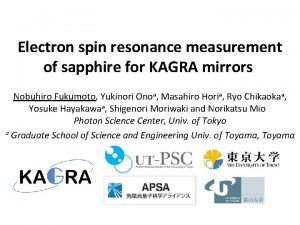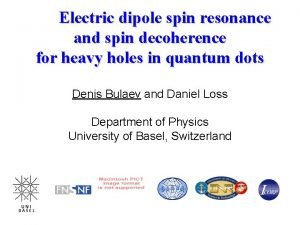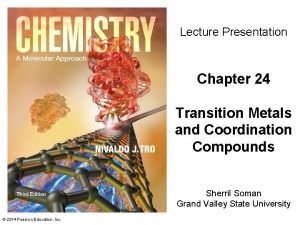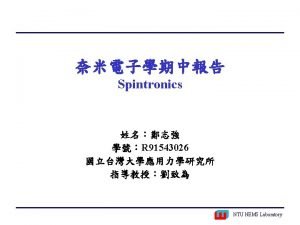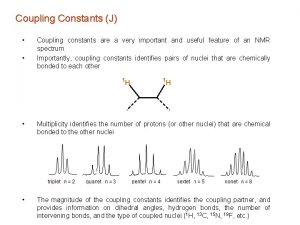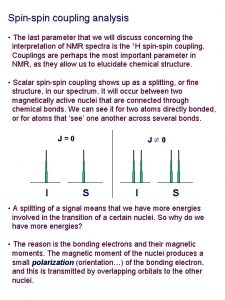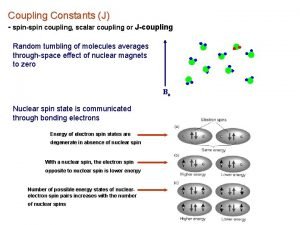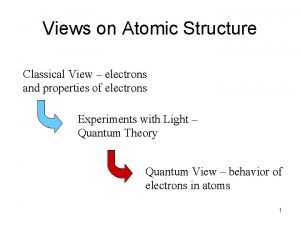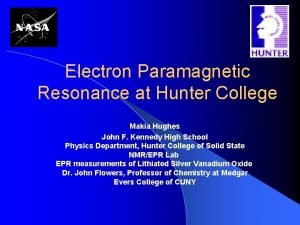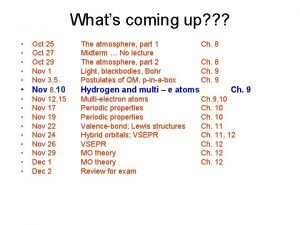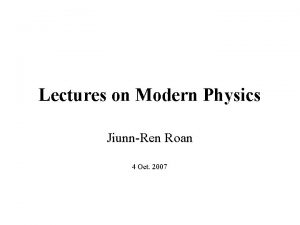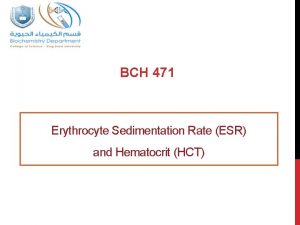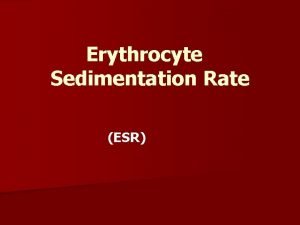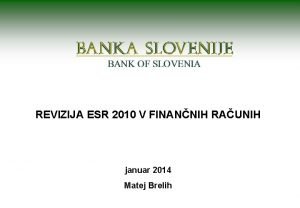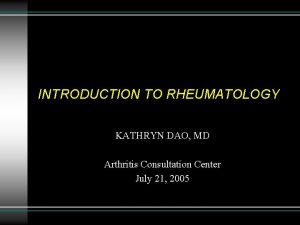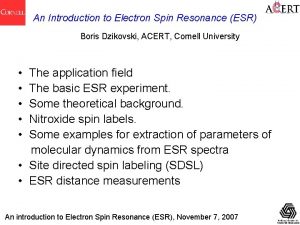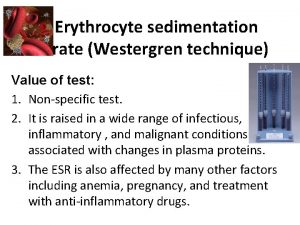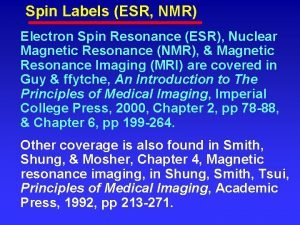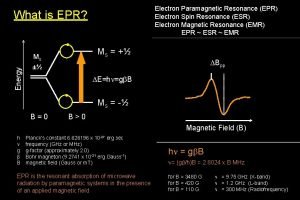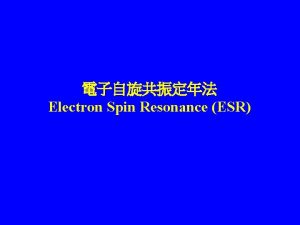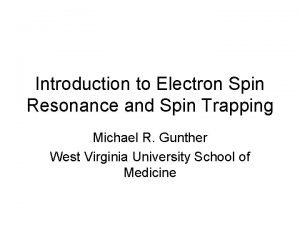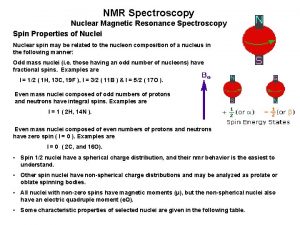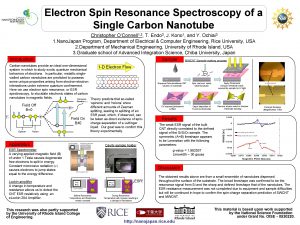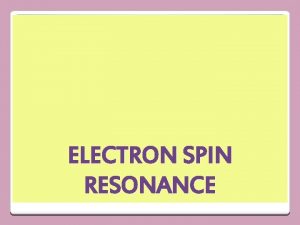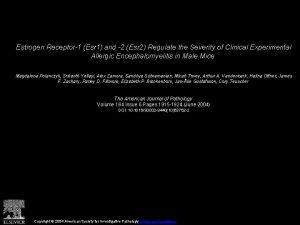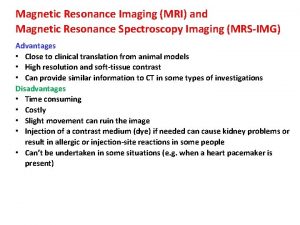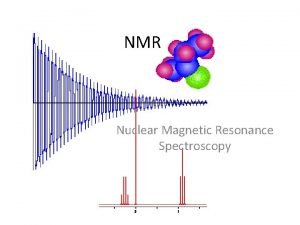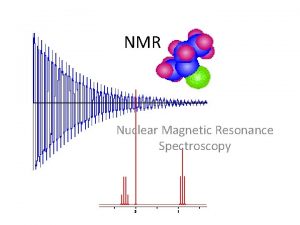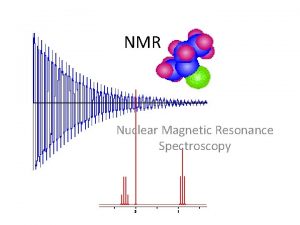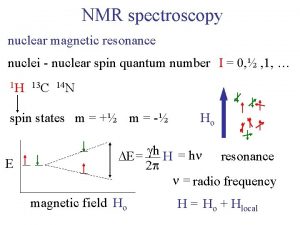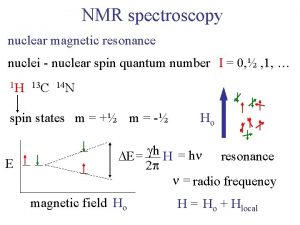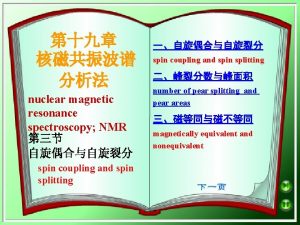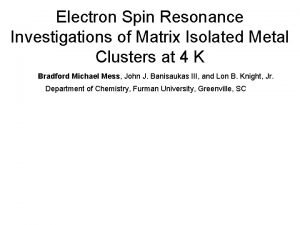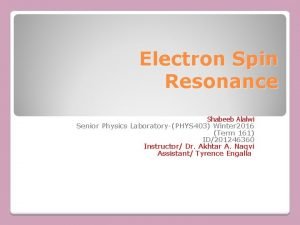Electron Spin Resonance Spectroscopy ESR Spectroscopy Electron Spin





















![Hyperfine Interactions • Example: – Radical anion of benzene [C 6 H 6]– Electron Hyperfine Interactions • Example: – Radical anion of benzene [C 6 H 6]– Electron](https://slidetodoc.com/presentation_image_h/14f4615f662b76b3e38331bdf17c532c/image-22.jpg)





- Slides: 27

Electron Spin Resonance Spectroscopy

ESR Spectroscopy • Electron Spin Resonance Spectroscopy • Also called EPR Spectroscopy – Electron Paramagnetic Resonance Spectroscopy • Non-destructive technique • Applications – Oxidation and reduction processes – Reaction kinetics – Examining the active sites of metalloproteins 2

What compounds can you analyze? • Applicable for species with one or more unpaired electrons – Free radicals – Transition metal compounds • Useful for unstable paramagnetic compounds generated in situ – Electrochemical oxidation or reduction 3

Energy Transitions • ESR measures the transition between the electron spin energy levels – Transition induced by the appropriate frequency radiation • Required frequency of radiation dependent upon strength of magnetic field – Common field strength 0. 34 and 1. 24 T – 9. 5 and 35 GHz – Microwave region 4

How does the spectrometer work? 5

What causes the energy levels? Resulting energy levels of an electron in a magnetic field Ebsworth, E. A. V. ; Rankin, David W. H. ; Cradock, Stephen Structural Methods in Inorganic Chemistry; CRC Press: Boca Raton, 1987. 6

Spectra When phase-sensitive detection is used, the signal is the first derivative of the absorption intensity 7

Describing the energy levels • Based upon the spin of an electron and its associated magnetic moment • For a molecule with one unpaired electron – In the presence of a magnetic field, the two electron spin energy levels are: E = gm. BB 0 MS g = proportionality factor m. B = Bohr magneton MS = electron spin B 0 = Magnetic field quantum number (+½ or -½) 8

Proportionality Factor • Measured from the center of the signal • For a free electron – 2. 00232 • For organic radicals – Typically close to freeelectron value – 1. 99 -2. 01 • For transition metal compounds – Large variations due to spin-orbit coupling and zero-field splitting – 1. 4 -3. 0 9

Proportionality Factor Mo. O(SCN)52 - 1. 935 VO(acac)2 1. 968 e- 2. 0023 CH 3 2. 0026 C 14 H 10 (anthracene) cation 2. 0028 C 14 H 10 (anthracene) anion 2. 0029 Cu(acac)2 2. 13 Atherton, N. M. Principles of Electron Spin Resonance; Ellis Horwood: Chichester, 1993. 10

Hyperfine Interactions • EPR signal is ‘split’ by neighboring nuclei – Called hyperfine interactions • Can be used to provide information – Number and identity of nuclei – Distance from unpaired electron • Interactions with neighboring nuclei E = gm. BB 0 MS + a. Msm. I a = hyperfine coupling constant m. I = nuclear spin quantum number • Measured as the distance between the centers of two signals 11

Which nuclei will interact? • Selection rules same as for NMR • Every isotope of every element has a ground state nuclear spin quantum number, I – has value of n/2, n is an integer • Isotopes with even atomic number and even mass number have I = 0, and have no EPR spectra – 12 C, 28 Si, 56 Fe, … • Isotopes with odd atomic number and even mass number have n even – 2 H, 10 B, 14 N, … • Isotopes with odd mass number have n odd – 1 H, 13 C, 19 F, 55 Mn, … 12

Hyperfine Interactions Interaction with a single nucleus of spin ½ Ebsworth, E. A. V. ; Rankin, David W. H. ; Cradock, Stephen Structural Methods in Inorganic Chemistry; CRC Press: Boca Raton, 1987. 13

Hyperfine Interactions • Coupling patterns same as in NMR • More common to see coupling to nuclei with spins greater than ½ • The number of lines: 2 NI + 1 N = number of equivalent nuclei I = spin • Only determines the number of lines--not the intensities 14

Hyperfine Interactions • Relative intensities determined by the number of interacting nuclei • If only one nucleus interacting – All lines have equal intensity • If multiple nuclei interacting – Distributions derived based upon spin – For spin ½ (most common), intensities follow binomial distribution 15

Relative Intensities for I = ½ N Relative Intensities 0 1 1 1: 1 2 1: 2: 1 3 1: 3: 3: 1 4 1: 4: 6: 4: 1 5 1 : 5 : 10 : 5 : 1 6 1 : 6 : 15 : 20 : 15 : 6 : 1 16

Relative Intensities for I = ½ 17

Relative Intensities for I = 1 N Relative Intensities 0 1 1 1: 1: 1 2 1: 2: 3: 2: 1 3 1: 3: 6: 7: 6: 3: 1 4 1 : 4 : 10 : 16 : 19 : 16 : 10 : 4 : 1 5 1 : 5 : 15 : 20 : 45 : 51 : 45 : 20 : 15 : 1 6 1 : 6 : 21 : 40 : 80 : 116 : 141 : 116 : 80 : 40 : 21 : 6 : 1 18

Relative Intensities for I = 1 19

Hyperfine Interactions • Example: – VO(acac)2 – Interaction with vanadium nucleus – For vanadium, I = 7/2 – So, 2 NI + 1 = 2(1)(7/2) + 1 = 8 – You would expect to see 8 lines of equal intensity 20

Hyperfine Interactions EPR spectrum of vanadyl acetylacetonate 21
![Hyperfine Interactions Example Radical anion of benzene C 6 H 6 Electron Hyperfine Interactions • Example: – Radical anion of benzene [C 6 H 6]– Electron](https://slidetodoc.com/presentation_image_h/14f4615f662b76b3e38331bdf17c532c/image-22.jpg)
Hyperfine Interactions • Example: – Radical anion of benzene [C 6 H 6]– Electron is delocalized over all six carbon atoms • Exhibits coupling to six equivalent hydrogen atoms – So, 2 NI + 1 = 2(6)(1/2) + 1 = 7 – So spectrum should be seven lines with relative intensities 1: 6: 15: 20: 15: 6: 1 22

Hyperfine Interactions EPR spectrum of benzene radical anion 23

Hyperfine Interactions • Coupling to several sets of nuclei – First couple to the nearest set of nuclei • Largest a value – Split each of those lines by the coupling to the next closest nuclei • Next largest a value – Continue 2 -3 bonds away from location of unpaired electron 24

Hyperfine Interactions • Example: – Pyrazine anion – Electron delocalized over ring • Exhibits coupling to two equivalent N (I = 1) 2 NI + 1 = 2(2)(1) + 1 = 5 • Then couples to four equivalent H (I = ½) 2 NI + 1 = 2(4)(1/2) + 1 = 5 – So spectrum should be a quintet with intensities 1: 2: 3: 2: 1 and each of those lines should be split into quintets with intensities 1: 4: 6: 4: 1 25

Hyperfine Interactions EPR spectrum of pyrazine radical anion 26

Conclusions • Analysis of paramagnetic compounds – Compliment to NMR • Examination of proportionality factors – Indicate location of unpaired electron • On transition metal or adjacent ligand • Examination of hyperfine interactions – Provides information on number and type of nuclei coupled to the electrons – Indicates the extent to which the unpaired electrons are delocalized 27
 Electron spin resonance takes in
Electron spin resonance takes in Electric dipole spin resonance
Electric dipole spin resonance Low spin and high spin complex
Low spin and high spin complex Spin up spin down
Spin up spin down Spin-spin coupling examples
Spin-spin coupling examples Spin spin coupling
Spin spin coupling Spin spin coupling
Spin spin coupling Resonance delocalization
Resonance delocalization Heisenberg uncertainty principle
Heisenberg uncertainty principle Electron spin
Electron spin Electron spin
Electron spin Electron spin animation
Electron spin animation Electron spin
Electron spin Electron spin
Electron spin Electron spin
Electron spin Electron spin
Electron spin Esr normal range in female
Esr normal range in female Esr ecosystem
Esr ecosystem Esr crp
Esr crp Normal range of esr in male
Normal range of esr in male Nursing care for rheumatoid arthritis
Nursing care for rheumatoid arthritis Normal range of esr in male
Normal range of esr in male Esr 2010
Esr 2010 Articular vs non articular
Articular vs non articular Esr and nmr
Esr and nmr Esr normal range
Esr normal range Corrected esr formula
Corrected esr formula Esr rahoitus
Esr rahoitus
